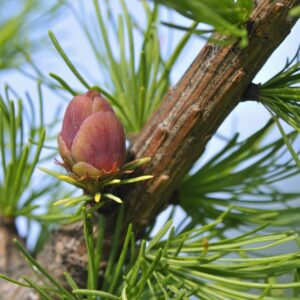Showing the single result
Appearance
As stated previously, larch trees look like normal coniferous trees during the spring and summer months. Their bright green needles are soft and feathery to the touch. They are also quite small, only growing about an inch to two inches long with each cluster containing 30 to 40 needles at most. During these warmer months, you may find pink flowers in between the needles. These flowers will eventually produce cones that start out red or yellow and then turn brown as they mature.
When fall approaches, changes occur that make the larch tree so unique. Unlike most conifers, their needles will turn bright yellow or golden in color. The needles will then fall off the tree as you inch closer and closer to winter, ultimately leaving the tree bare by December or January. Don’t worry, though. Just like normal leaves, the needles will grow back by springtime.
GET THE FACTS
About Larch Trees
Other than being one of the few conifers to change with the seasons, what else should you know about the larch tree? Here are just some basic facts to get you started:
They’re Native to Cold Climate Zones
Larches love the cold. Much of this has to do with their origins, which lay in the northern regions of our planet. Larch species are predominantly found in the forests of Russia, Scandinavia, and Canada. As such, they grow best in USDA plant hardiness zones 2 through 6.
They’re Fast Growers
When you plant a larch tree, you won’t have to wait long for it to start growing. These trees are fast growers. They will be looming over your home before you know it. And indeed, they can grow to great heights. They can reach up anywhere from 50 to 80 feet tall, though some can grow to 150 feet.
They Have a Wide Variety of Uses
Not only do they make a great backdrop to your lawn or garden, but larches have many other uses as well. Larch trees are highly valued for their hard wood. As such, they’re used in many everyday items, including yachts, fences, roof shingles, buildings, posts, interior paneling, coffins, and more.
They’re a Very Hardy Tree
The larch tree’s hard, thick bark is not only useful for making houses. It also makes larches an extremely hardy species of tree. The bark is practically impenetrable, meaning it can withstand a wide variety of weather conditions. So hardy are these trees that they can even stand against forest fires.
How to Grow Larch Trees
These massive, hardy trees sound like a handful, but in fact they’re very easy to grow. As long as they’re planted colder climates (USDA zones 2 through 6 to be exact), they will flourish. Find an area in your lawn or garden that gets at least six hours of direct sunlight each day and then sit back and watch your larch tree grow.
How to Care for Larch Trees
Larch trees are just as easy to care for as they are to grow. Once planted, the most you’ll have to do is water your larch tree regularly. Larches prefer moist soil, so make sure it never dries out. If you live in a rainy area, you likely won’t have to water it as much. However, if you’re experiencing a dry spell, keep an eye on the surrounding soil and water it whenever it starts to feel dry. You can also place a layer of organic mulch around the base to help the soil retain moisture.
Common Problems for Larch Trees
Larch trees have very few problems to deal with. As stated previously, they’re an extremely hardy tree, able to withstand even the toughest weather conditions. Nevertheless, they can be susceptible to diseases, pests, and more. Dwarf mistletoe is the most common problem that a larch tree will have to face. These are parasitic plants that will grow inside the larch tree, causing an infection. The point of infection will swell and create “witches’ brooms,” small, ball-shaped growths that look like a bundle of twigs. Dwarf mistletoe can cause serious damage to your larch tree, so it’s important to spot it early to prevent further harm.
How to Grow Larch Trees
These massive, hardy trees sound like a handful, but in fact they’re very easy to grow. As long as they’re planted colder climates (USDA zones 2 through 6 to be exact), they will flourish. Find an area in your lawn or garden that gets at least six hours of direct sunlight each day and then sit back and watch your larch tree grow.
How to Care for Larch Trees
Larch trees are just as easy to care for as they are to grow. Once planted, the most you’ll have to do is water your larch tree regularly. Larches prefer moist soil, so make sure it never dries out. If you live in a rainy area, you likely won’t have to water it as much. However, if you’re experiencing a dry spell, keep an eye on the surrounding soil and water it whenever it starts to feel dry. You can also place a layer of organic mulch around the base to help the soil retain moisture.
Common Problems for Larch Trees
Larch trees have very few problems to deal with. As stated previously, they’re an extremely hardy tree, able to withstand even the toughest weather conditions. Nevertheless, they can be susceptible to diseases, pests, and more. Dwarf mistletoe is the most common problem that a larch tree will have to face. These are parasitic plants that will grow inside the larch tree, causing an infection. The point of infection will swell and create “witches’ brooms,” small, ball-shaped growths that look like a bundle of twigs. Dwarf mistletoe can cause serious damage to your larch tree, so it’s important to spot it early to prevent further harm.

